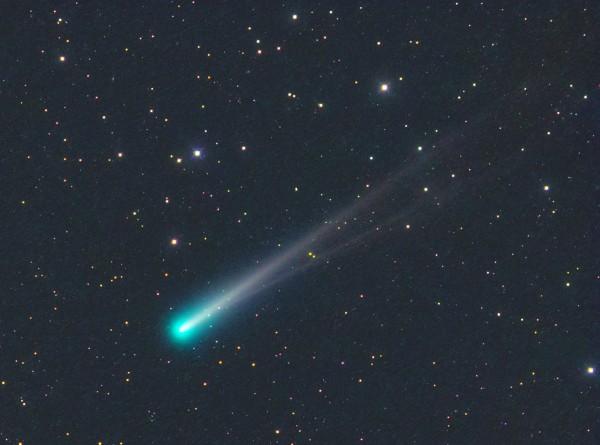Skywatchers Enjoy Comet Bonanza
All four comets now visible in the pre-dawn skies are captured on November 7 from the Sormano Astronomical Observatoy in Italy. Credit: www.osservatoriosormano.it
Backyard astronomers in the Northern Hemisphere get an eyeful this week, when four comets will be visible with binoculars or small telescopes in the early morning sky.
First up, the most famous of the bunch is Comet ISON, which is currently speeding towards its close encounter with the sun on November 28. While it has disappointed many for not being as bright, so far, as initially predicted it would be at this point in its orbit of the sun, it has in the last few weeks become a target visible in binoculars (Magnitude 8) from dark skies.
UPDATE: As of November 14, observers are reporting ISON is undergoing a sudden, unexpected outburst in brightness that has occurred in a 24 hour period. According to some estimates its has brightened to magnitude 6 – on the the threshold of naked-eye visibility.
According to spaceweather.com, this boost of activity may be due to pristine ice being suddenly vaporized by exposure to intense solar heat as the comet approaches the sun. This may only be a temporary brightening and it could fade back again – especially if it is disintegrating. But if this brightening trend does continue, ISON may become an easy target with the unaided eye in a weeks time. So now is a great time to get out and watch what ISON will do next.
Look for ISON traveling through the constellation Virgo, in the low eastern sky from 1 to 2 hours before dawn.
This skychart shows the general location of all 4 comets in the eastern pre-dawn sky of November 15, as seen from mid-northern latitudes . Credit: Starry Night Software/ A.Fazekas
On November 17 and 18, the comet will pose with the constellation’s brightest star, Spica, making it much easier to hunt down for sky-watchers in light-polluted areas.
Observers report that ISON sports a distinct ‘double’ tail, which is visible in photographs taken over the last few days. Both trail behind the comet’s fuzzy nucleus. One tail points directly away from the sun. It is made of ionized gas being swept away by solar wind. The second tail is composed of dust grains flying off the comet’s surface, and appears slightly curved. It follows the orbit of the comet.
The double tail of Comet ISON is captured in this photo taken through an 8 inch telescope in Jauerling Austria on November 10.
Expectations are that ISON will continue to brighten as it approaches the sun, where hotter temperatures will start melting the icy interloper. Best views are expected after it has rounded the sun at the end of November—as long as it has not disintegrated from the scorching heat and intense gravitational pull of the sun. However, current predictions suggest that the comet will not attain the superstar status that it was once hoped for, such as becoming as bright as the moon.
Since comets are notoriously unpredictable, there is still a chance it may become a bright naked eye object, putting on a nice sky show with a long, sweeping tail viewable in dark skies from December to January, as it heads back towards the outer solar system.
While Comet ISON has certainly been getting all the attention, another comet named Lovejoy is now actually outperforming it , shining nearly ten times brighter in the pre-dawn skies and is easily picked up in ordinary 7 x 50 binoculars.
Photographs show that Lovejoy has a pale green, fuzzy nucleus twice as wide as the planet Jupiter, and that it has at least three tails trailing behind it. Over the next week or so, the comet will appear high in the southeastern sky and glide just underneath the bowl of the Big Dipper.
This stunning photo of Comet Lovejoy was taken through an 8 inch telescope in Jauerling Austria on November 10.
The other two comets, 2P/Encke and LINEAR (C/2012 X1), are less impressive, being somewhat fainter and best seen with backyard telescopes. What makes them more of an observing challenge as well is that they are both very low to the eastern horizon, visible just as morning twilight breaks. Reports are that Encke has a smaller-but-brighter nucleus than ISON, making it the easier of these two faint comets to spot.
Sky and Telescope website offers detailed finders charts for ISON and Lovejoy, and you can find brightness information and printable skycharts for all four comets at comets.skyhound.net.
Comet LINEAR sports a stubby tail and is much fainter than Comet Lovejoy. s seen in this November 8 photo. Credit: Michael Jäger
Novice comet hunters will get a chance to use some convenient guideposts in the sky to track down both of these faint comets over the next week or so. Between November 15 and 18, LINEAR will glide past the bright orange star Arcturus, and between November 18 and 20, Encke will pass by the innermost planet in the solar system, Mercury.
Having four comets grace our Earthly skies at once is an exceptional sight, even though you may have to wake-up extra early to catch all the cosmic action. What a way to start your day!(Posted by Andrew Fazekas in StarStruck on November 14, 2013)
















